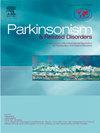随着时间的推移,快速发作的肌张力障碍-帕金森病的神经学和精神病学特征。
IF 3.1
3区 医学
Q2 CLINICAL NEUROLOGY
引用次数: 0
摘要
简介:快速发作性肌张力障碍-帕金森病(RDP)的症状通常持续数天至数周,通常由发烧或分娩等应激源引发。关于运动和非运动症状在疾病过程中如何演变的信息有限。我们的纵向研究分析了一组RDP患者的数据,记录了他们多次就诊时的症状。方法:对14例ATP1A3突变阳性个体(7例女性,7例男性;平均检查年龄37岁,平均发病年龄20岁。我们着重于在亲自访问期间收集的神经学、认知学和神经心理学数据(测试之间的平均间隔= 5年半)。结果:最初,所有参与者都表现出球茎症状。头痛占50%,癫痫发作占31%,震颤占36%。在随访中,最初没有头痛的患者中有29%出现了头痛,22%没有癫痫发作的患者出现了头痛,56%之前没有震颤的患者出现了头痛。头痛患者的情况没有改善;然而,癫痫发作和震颤分别在25%和80%的病例中得到改善。对于伯克-法恩-马斯登肌张力障碍评定量表、统一帕金森病评定量表和国际合作共济失调评定量表的评分,改善包括症状的减轻。随着时间的推移,认知功能从轻度受损改善到低平均水平,精神病学评估显示轻度焦虑水平,强迫行为轻微增加,抑郁评分下降。结论:这项纵向分析强调了RDP的复杂演变,显示了运动功能和其他症状(如头痛、癫痫发作和震颤)的显著变异性。本文章由计算机程序翻译,如有差异,请以英文原文为准。
Neurological and psychiatric characterization of rapid-onset dystonia-parkinsonism over time
Introduction
The onset of symptoms in Rapid-onset dystonia-parkinsonism (RDP) is typically over days to weeks and is often triggered by stressors like fever or childbirth. Limited information is available on how the motor and nonmotor symptoms evolve over the course of the disease. Our longitudinal study analyzed data from a cohort of RDP patients, documenting their symptoms across multiple visits.
Methods
We characterized the phenotypic evolution of 14 individuals positive for ATP1A3 mutations (7 females, 7 males; mean examination age = 37 years, mean age of onset = 20 years). We focused on neurologic, cognitive, and neuropsychological data collected during in-person visits (mean interval between testing = 5½ years).
Results
Initially, all participants exhibited bulbar symptoms. Headaches were noted in 50 %, seizures in 31 %, and tremors in 36 %. At follow-up, 29 % of those initially without headaches developed them, 22 % without prior seizures experienced them, and 56 % previously without tremors developed them. No improvements were seen in those with headaches; however, seizures and tremors improved in 25 % and 80 % of cases, respectively. For Burke-Fahn-Marsden Dystonia Rating Scale, Unified Parkinson's Disease Rating Scale, and International Cooperative Ataxia Rating Scale scores, improvement consisted of the reduction of the symptom. Cognitive functions improved from mildly impaired to low-average, and psychiatric evaluations indicated mild anxiety levels, slight increases in obsessive-compulsive behaviors, and decreased depression scores over time.
Conclusions
This longitudinal analysis highlights the complex evolution of RDP, demonstrating significant variability in motor function and other symptoms such as headaches, seizures, and tremors.
求助全文
通过发布文献求助,成功后即可免费获取论文全文。
去求助
来源期刊

Parkinsonism & related disorders
医学-临床神经学
CiteScore
6.20
自引率
4.90%
发文量
292
审稿时长
39 days
期刊介绍:
Parkinsonism & Related Disorders publishes the results of basic and clinical research contributing to the understanding, diagnosis and treatment of all neurodegenerative syndromes in which Parkinsonism, Essential Tremor or related movement disorders may be a feature. Regular features will include: Review Articles, Point of View articles, Full-length Articles, Short Communications, Case Reports and Letter to the Editor.
 求助内容:
求助内容: 应助结果提醒方式:
应助结果提醒方式:


